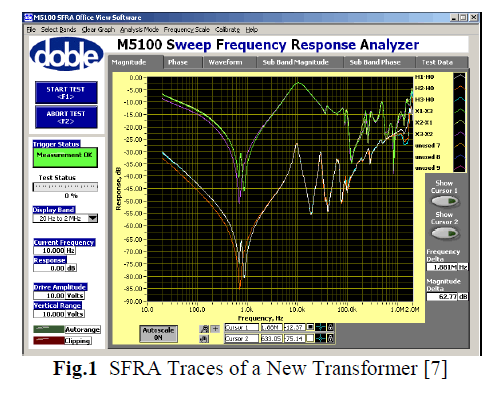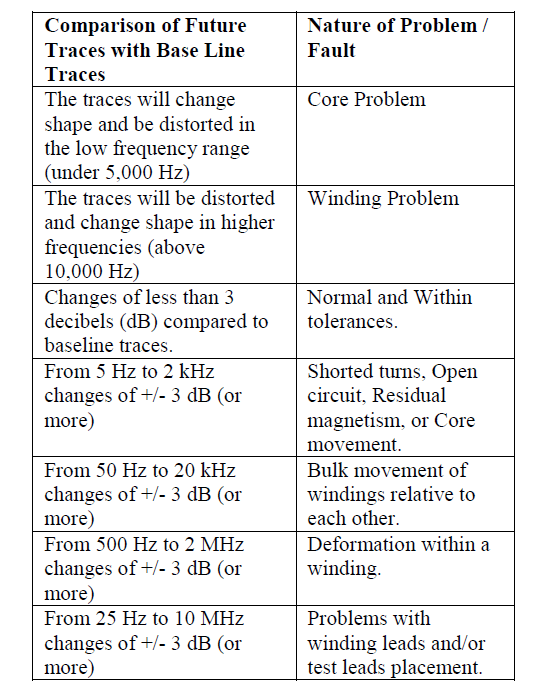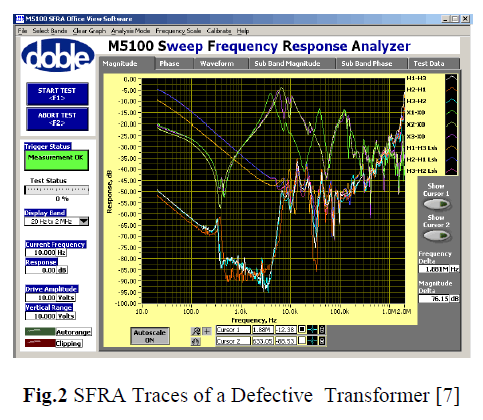ISSN ONLINE(2278-8875) PRINT (2320-3765)
ISSN ONLINE(2278-8875) PRINT (2320-3765)
AKSHAY A. PANDYA 1, DR.(PROF.) B.R.PAREKH 2
|
| Related article at Pubmed, Scholar Google |
Visit for more related articles at International Journal of Advanced Research in Electrical, Electronics and Instrumentation Engineering
Sweep frequency response analysis is a major advance in transformer condition analysis. Frequency response is performed by applying a low voltage signal of varying frequencies to the transformer windings and measuring both the input and output signals. The ratio of these two signals gives the required response. This ratio is called the transfer function of the transformer from which both the magnitude and phase can be obtained. Changes in frequency response as measured by SFRA techniques may indicate a physical change inside the transformer, the cause of which then needs to be identified and investigated.
Keywords |
| SFRA, Power Transformer, Frequency Response Analyzer, SFRA Traces |
INTRODUCTION |
| Sweep Frequency Response Analysis (SFRA) is a tool that can give an indication of core or winding movement in transformers. The transformer is considered to be a complex network of RLC components. Any form of physical damage to the transformer results in the changes of this RLC network. These changes are what we are looking for and employ frequency response to highlight these small changes in the RLC network within the transformer. For different frequencies the RLC network offers different impedance paths. Hence, the transfer function at each frequency is a measure of the effective impedance of the RLC network of the transformer. Any geometrical deformation changes the RLC network, which in turn changes the transfer function at different frequencies and hence highlights the area of concern [11]. |
II FREQUENCY RESPONSE ANALYZER |
| The SFRA test is non-destructive test. SFRA is an OFF-Line testing and it can be carried out for any voltage rating of Power Transformer. The measurement of SFRA can be a part of regular transformer maintenance. |
| The SFRA Analyzer identifies the following abnormalities in the transformer before they lead to failure. |
| * Core Movement |
| * Winding deformation and displacement |
| * Faulty core ground |
| * Partial winding collapse |
| * Hoop Buckling |
| * Broken or loosened clamping structures |
| * Shorted turns and open winding. |
| The technique of SFRA is a major advance in transformer condition monitoring analysis. This is a proven technique for making accurate and repeatable measurements. |
| The test can be carried out, |
| (a) First to obtain initial signature of the transformer sweep frequency response as a record for the future reference / comparision. |
| (b) Periodical measurement as a maintenance check, once in two years. |
| (c) Immediately after a major external shortcuit, specially for faults electrically closer to transformer. |
| (d) Transportation or re-location of transformer. |
| (e) Earthquakes. |
| (f) Pre-commissioning check.[1] |
III SWEEP FREQUENCY RESPONSE TEST |
| These tests show, in trace form, the winding transfer function of the transformer and are valuable to determine if any damage has occurred during shipping or during a through fault. Core grounds, core displacement, and other core and winding problems can be revealed by this test. |
| These tests should be conducted before and after the transformer has been moved or after experiencing a through fault. Results should be compared to baseline tests performed at the factory or as soon as possible after receiving the transformer. If the SFRA tests cannot be performed at the factory, they should be conducted as an acceptance test before energizing a new or rebuilt transformer to establish a baseline. |
| SFRA testing for a delta/wye transformer has been performed as per following way. |
| *A test voltage of variable frequency (normally 20 Hz to 2 MHz) is placed across each phase of the high voltage winding. With this set of tests, low voltage windings are isolated with no connections on any of the bushings. |
| * An additional set of tests is performed by short circuiting all the low voltage windings and again placing the test voltage on each phase of the high voltage winding. |
| *A third set of tests is made by isolating the high voltage winding and placing the test voltage across each low voltage winding. |
| Figure 1 is a picture of test traces on a new three-phase transformer. The top three traces were taken on the low voltage side, X1-X3, X2-X1, and X3-X2. The two outside windings (A and C phases) have the same general shape with a “W” at the lowest point of the trace, while the inside winding (B phase) has a “V” at the bottom. The high voltage traces (lower three) have the same characteristics. Note that, in both high and low voltage tests, the traces fall almost perfectly on top of each other for the outside windings (A and C), while the inside winding (B phase), is slightly displaced to the left. These are characteristic traces of a three-phase transformer in good condition; these traces will be the baseline for future tests on this transformer. |
 |
| By comparing future traces with baseline traces, the following can be noted. |
 |
| Note that there is a great deal of overlap in frequencies, which can mean more than one diagnosis. |
| Figure 2 shows traces of a transformer with a problem. The traces have the same general positions on the graph as the good transformer. The lower traces are high voltage winding tests, while the upper traces are the low voltage winding tests. Note in the higher frequencies of the low voltage traces that “A” phase (X1-X0 green trace) is displaced from the other two phases more than 3 dB from about 4 kHz to about 50 kHz. With a healthy transformer, these would fall almost on top of each other as the other two phases do. Also notice that “A” phase (H1H3Lsh) is displaced in the test with the low voltage winding shorted. There is an obvious problem with “A” phase on the low voltage side. After opening the transformer, it was found that the “A” phase winding lead had burned off near the winding connection and re-welded itself on the winding at a different location, effectively shorting out a few turns. The transformer was still working, but hot metal gases (ethylene, ethane, methane) were actively generating and showing up in the DGA. Although other tests could have revealed this problem, SFRA showed the problem was with “A” phase and, therefore, where to concentrate the internal inspection.[7] |
 |
IV CONCLUSION |
| SFRA is a powerful tool for the detection of winding movement and other faults that affect the transformer impedence. It also covers low frequencies and thus can detect core faults, shorted or open turns. |
| SFRA measuring directly in frequency domain hence no further mathematical handling of data ia necessary. An advantage is that reference responses are not required to make an accurate decision as a comparison of response to the different phase of the same transformer and a comparison of response from sister transformer are uesd successfully to diagnose the mechanical integrity of the transformer. |
| SFRA when used in conjuction with other diagnostic tools can provide a complete condition assessment of the transformer. |
References |
|